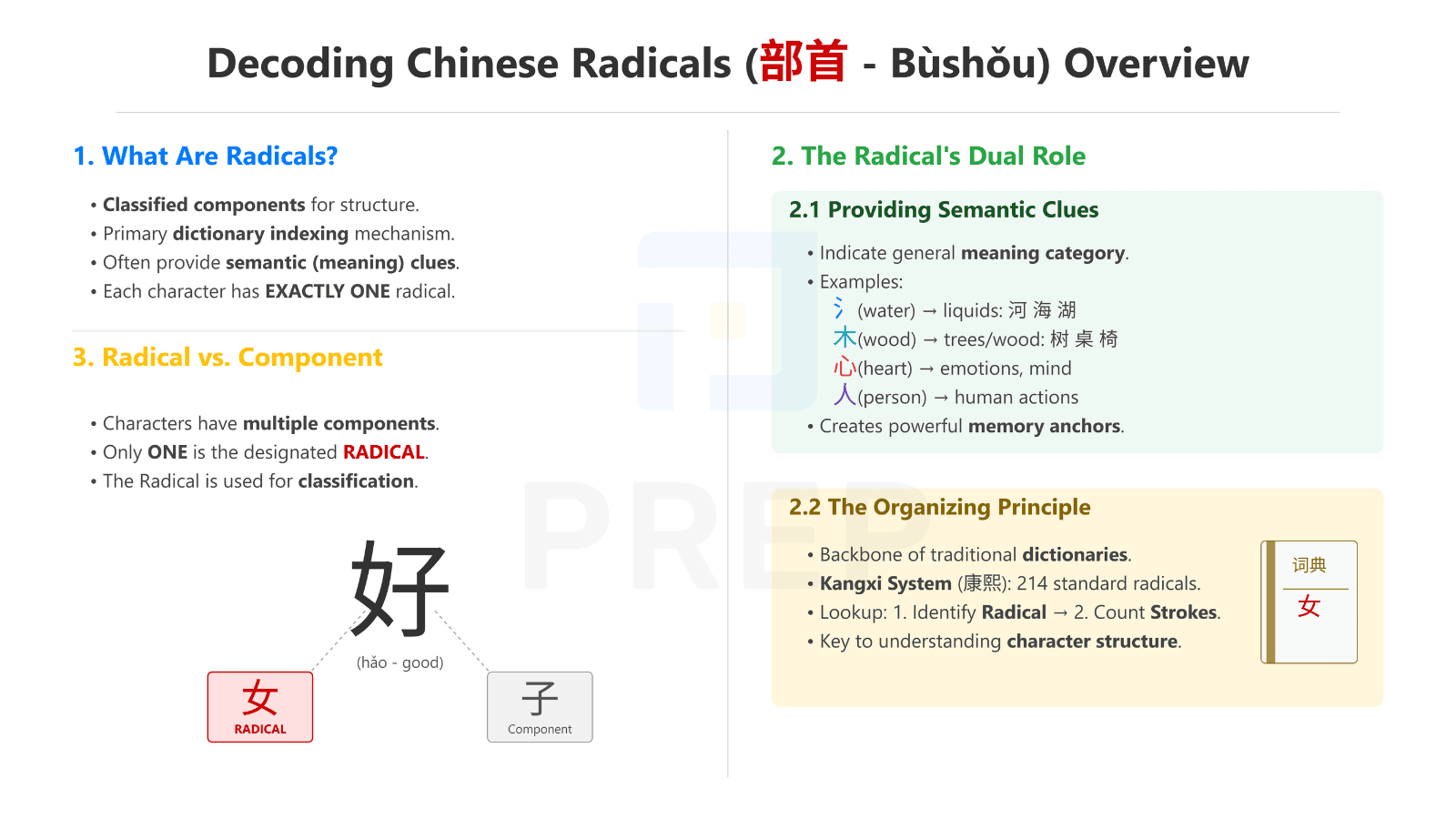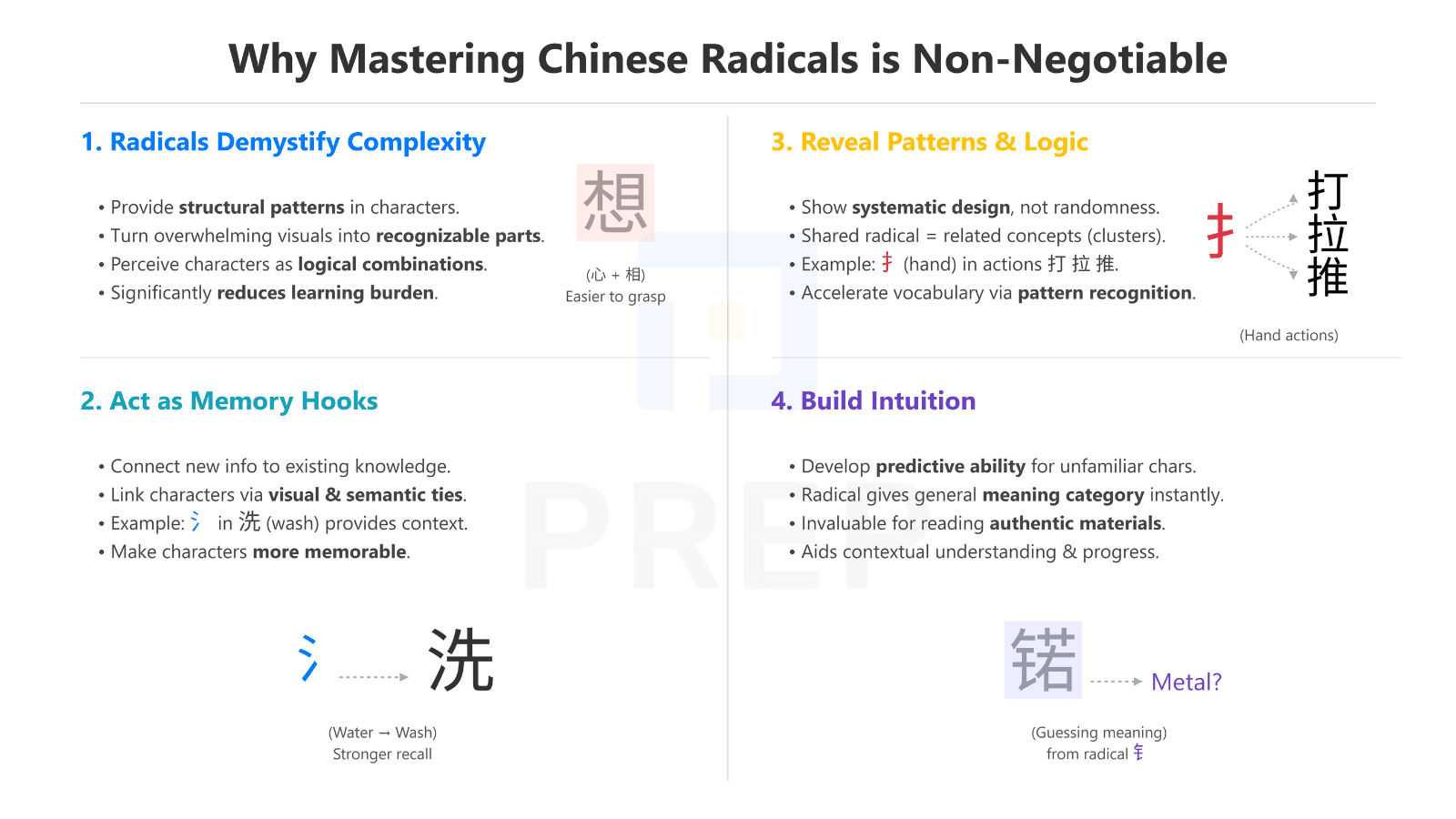Chinese Radicals Explained: Your Ultimate Guide to Understanding and Mastering Hanzi
Feeling overwhelmed by the complexity of Chinese characters? You've discovered the secret key to unlock their meaning. Chinese radicals (部首 - bùshǒu) form the foundational elements that bring structure and meaning to the seemingly impenetrable world of Hanzi. This comprehensive guide will equip you with the knowledge to identify, understand, and leverage these building blocks for effective character learning.
- I. Decoding the Foundation: What Are Radicals in Chinese (部首 - Bùshǒu)?
- II. Why Mastering Chinese Radicals is non-Negotiable for Serious Learners
- III. Navigating Radical Systems: From Tradition to Practical Application
- IV. Effective Strategies: How to Learn and Retain Chinese Radicals Efficiently
- 1. Strategy 1: Prioritize by Frequency and Relevance
- 2. Strategy 2: Create Strong Visual & Meaning Associations
- 3. Strategy 3: Leverage Spaced Repetition Systems (SRS) Tools
- 4. Strategy 4: Make Radical Analysis a Habit with Every New Character
- 5. Strategy 5: Reinforce with Writing Practice and Component Analysis
- 6. A Crucial Note: Understanding the Limits of Radical Prediction
- VI. Expanding Your Knowledge: Answering Key Questions About Radicals
- 1. What Distinguishes a Radical from Other Character Components?
- 2. Can a Single Radical Function as a Complete Character?
- 3. How Different Are Radicals Between Simplified and Traditional Systems?
- 4. Are There Primary Categories That Group Related Radicals?
- 5. Does Knowing the Radical Help Predict a Character's Pronunciation?
- VI. Beyond the Basics: Consolidating Your Radical Knowledge for Fluency

I. Decoding the Foundation: What Are Radicals in Chinese (部首 - Bùshǒu)?
1. Defining the Essential Building Blocks of Chinese Characters
Chinese radicals (部首 - bùshǒu) serve as the classified components of characters that provide organizational structure to the writing system. These graphical elements function as the primary indexing mechanism in traditional dictionaries and often offer semantic clues about a character's meaning. Every Chinese character contains exactly one radical, which serves as its classificatory element in any comprehensive Chinese radical dictionary.

2. More Than Just Strokes: Understanding the Radical's Dual Role
2.1. Providing Semantic Clues: How Radicals Hint at Meaning
Radicals frequently indicate the semantic category or general meaning field of a character. They operate as conceptual markers that can guide your understanding. The water radical (氵), for instance, appears in characters related to liquids such as 河 (hé - river), 海 (hǎi - sea), and 湖 (hú - lake). Similarly, the wood radical (木) appears in terms connected to trees or wooden objects: 树 (shù - tree), 桌 (zhuō - table), and 椅 (yǐ - chair).
These semantic connections, while not absolute rules, provide valuable cognitive frameworks for recognizing character patterns. The heart radical (心) often relates to emotions and mental states, while the person radical (人) frequently appears in characters describing human actions or attributes. Understanding these relationships creates powerful memory anchors during your learning journey.
2.2. The Organizing Principle: Radicals for Dictionary Lookup and Classification
Historically, Chinese radicals formed the backbone of character organization. The Kangxi radicals system established 214 radicals that became the standard classification method for nearly three centuries. Before digital tools, locating characters in dictionaries required identifying the radical and counting additional strokes. While modern learners rarely use physical radical-indexed dictionaries, understanding this system remains essential for grasping character composition principles and the internal logic of Hanzi structure.
3. Radical vs. Component: Identifying the Key Piece in a Character
A crucial distinction exists between radicals and components. While Chinese characters may contain multiple components, only one element serves as the designated radical character for classification purposes. For example, the character 好 (hǎo - good) combines 女 (nǚ - woman) and 子 (zǐ - child), but only 女 functions as its radical. This distinction helps navigate the structural hierarchy within characters and provides clarity when analyzing complex forms.
II. Why Mastering Chinese Radicals is non-Negotiable for Serious Learners

1. Reason 1: Radicals Demystify Complex Characters
Confronted with thousands of unique characters, the brain seeks patterns to manage cognitive load. Radicals provide this structural framework, transforming overwhelming visual information into recognizable components. Rather than memorizing each character as an isolated collection of strokes, you'll develop the ability to perceive them as logical combinations of meaningful elements, significantly reducing the learning burden.
2. Reason 2: They Act as Powerful Memory Hooks (Mnemonics)
The human mind retains information more effectively when it connects to existing knowledge networks. Radicals create these connections by linking characters through visual and semantic associations. When you encounter 洗 (xǐ - to wash), recognizing the water radical (氵) immediately provides a conceptual framework, making the character more memorable than if approached as an arbitrary symbol.
3. Reason 3: Radicals Reveal Patterns and Logic Within Hanzi
Chinese writing embodies systematic design principles rather than random arrangements. Characters sharing the same radical often relate conceptually, creating natural learning clusters. The hand radical (扌) appears in action characters like 打 (dǎ - to hit), 拉 (lā - to pull), and 推 (tuī - to push), revealing logical relationships that accelerate vocabulary acquisition through pattern recognition rather than rote memorization.
4. Reason 4: They Build Intuition for Recognizing Unfamiliar Characters
As you internalize radical knowledge, you develop predictive abilities for unfamiliar characters. Even without knowing the exact pronunciation or specific definition, identifying the radical provides immediate information about the general meaning category. This skill proves invaluable when reading authentic materials where contextual understanding becomes crucial for comprehension progress.
III. Navigating Radical Systems: From Tradition to Practical Application
1. The Historical Benchmark: Understanding the Kangxi Radicals
The Kangxi radical system, established during the Qing Dynasty, created a comprehensive framework of 214 classifiers that organized the entire character corpus. This system provided structure to Chinese lexicography for generations and remains influential in modern linguistic understanding. While the complete set represents a thorough classification, contemporary learners benefit from focusing initially on high-frequency components rather than memorizing the entire inventory.
2. Focusing Your Study: The Power of High-Frequency Chinese Radicals
Research demonstrates that mastering approximately 100 common radicals provides coverage for the vast majority of characters encountered in everyday reading. This focused approach maximizes learning efficiency by prioritizing the elements with highest practical utility. The following radical chart emphasizes the simplified Chinese system used in mainland China and Singapore, though most principles apply equally to traditional characters used in Taiwan and Hong Kong.
The Essential List of Radicals: Key Elements for Learners
|
Radical |
Pinyin |
Core Meaning |
Example Characters |
Notes |
|
人, 亻 |
rén |
person |
他 (tā - he), 你 (nǐ - you) |
Often appears on left side as 亻 |
|
口 |
kǒu |
mouth, opening |
吃 (chī - eat), 喝 (hē - drink) |
Frequently indicates speech or ingestion |
|
女 |
nǚ |
woman, female |
好 (hǎo - good), 妈 (mā - mother) |
Originally depicted female form |
|
心, 忄 |
xīn |
heart, mind |
想 (xiǎng - think), 情 (qíng - emotion) |
Appears as 忄 on left side |
|
手, 扌 |
shǒu |
hand |
打 (dǎ - hit), 拿 (ná - take) |
Commonly 扌 on left side |
|
水, 氵 |
shuǐ |
water |
河 (hé - river), 海 (hǎi - sea) |
Typically 氵 on left side |
|
火, 灬 |
huǒ |
fire |
热 (rè - hot), 烧 (shāo - burn) |
Appears as 灬 at bottom |
|
木 |
mù |
tree, wood |
树 (shù - tree), 桌 (zhuō - table) |
Often indicates wooden items |
|
土 |
tǔ |
earth, soil |
地 (dì - ground), 场 (chǎng - field) |
Related to land and places |
|
金, 钅 |
jīn |
metal, gold |
铁 (tiě - iron), 银 (yín - silver) |
Usually 钅 on left side |
3. Spotting the Radical: Common Positions and Visual Variations
Radicals frequently change form depending on their position within a character. The person radical transforms from 人 to 亻 when positioned on the left side, as in 你 (nǐ - you). Similarly, the water radical changes from 水 to 氵 in left position, as in 河 (hé - river). Understanding these positional variations enables accurate character analysis and efficient lookup in any Chinese radical dictionary.
Certain positions correlate with specific functions. Left-side radicals often provide semantic hints (meaning), while right-side elements frequently indicate pronunciation. However, these patterns have numerous exceptions, requiring flexible application rather than rigid rules. The ability to identify radical variants across positions represents a crucial skill for efficient character recognition.
IV. Effective Strategies: How to Learn and Retain Chinese Radicals Efficiently

1. Strategy 1: Prioritize by Frequency and Relevance
Begin with the high-frequency radicals presented in this guide before expanding to less common ones. This approach ensures immediate practical application of your knowledge and provides quicker rewards for your investment. Focus first on radicals that appear in characters relevant to your current vocabulary goals to create meaningful learning connections.
2. Strategy 2: Create Strong Visual & Meaning Associations
Develop personalized mnemonic devices that connect the radical's form to its meaning. For instance, visualize the water radical (氵) as water droplets flowing down a surface or the fire radical (火) as flames rising upward. These visual hooks dramatically improve retention rates by engaging the brain's imagery systems alongside linguistic processing.
3. Strategy 3: Leverage Spaced Repetition Systems (SRS) Tools
Implement technology designed specifically for optimizing memory acquisition. Applications like Anki, Pleco's flashcard system, and Skritter utilize algorithms that present information at scientifically determined intervals to maximize retention while minimizing study time. Create dedicated radical character flashcards that include both form recognition and meaning association exercises.
4. Strategy 4: Make Radical Analysis a Habit with Every New Character
When encountering unfamiliar characters, immediately identify the radical rather than viewing the character holistically. This analytical approach builds neural pathways that automatically decompose complex forms into constituent elements. Gradually, this process becomes instinctive, dramatically accelerating character recognition speed and accuracy.
5. Strategy 5: Reinforce with Writing Practice and Component Analysis
Physical writing creates kinesthetic memory pathways that complement visual learning. Regularly practice writing radicals both in isolation and within characters, paying attention to proper stroke order and proportion. Additionally, analyze how radicals combine with other components to form complete characters, deepening your structural understanding of the writing system.
6. A Crucial Note: Understanding the Limits of Radical Prediction
While Chinese radicals provide valuable meaning cues, they rarely offer reliable pronunciation information. The phonetic component usually supplies this data in compound characters. Additionally, historical evolution and semantic shifts mean some characters contain radicals with non-obvious connections to their current meanings. Maintain realistic expectations about radical analysis to avoid frustration with apparent inconsistencies.
As you continue developing your radical knowledge, you'll naturally encounter questions about their application and limitations. The following section addresses common inquiries to provide a more complete understanding.
VI. Expanding Your Knowledge: Answering Key Questions About Radicals
1. What Distinguishes a Radical from Other Character Components?
A radical serves as the official classificatory element of a character, specifically designated for dictionary organization. While all radicals are components, not all components function as radicals. The distinction lies primarily in this organizational role rather than visual prominence or position within the character. Understanding what are radicals in Chinese writing requires recognizing this specialized classification function.
2. Can a Single Radical Function as a Complete Character?
Yes, many radicals exist independently as stand-alone characters. Common examples include 人 (rén - person), 口 (kǒu - mouth), 木 (mù - tree), 心 (xīn - heart), and 手 (shǒu - hand). These characters generally represent fundamental concepts and often appear as components within more complex characters. This dual nature adds significant utility to mastering the list of radicals.
3. How Different Are Radicals Between Simplified and Traditional Systems?
While many radicals remain identical across both systems, some undergo simplification following predictable patterns. For example, the speech radical simplifies from 言 to 讠. In certain cases, simplified characters adopt entirely different radicals than their traditional counterparts, as seen in 體 versus 体, which use different classification elements. The Kangxi radicals system primarily references traditional forms, though many principles apply to simplified characters as well.
4. Are There Primary Categories That Group Related Radicals?
Radicals typically fall into semantic groups like body parts (口, 目, 手), nature elements (水, 火, 土), actions (走, 行), and human attributes (心, 言). While not a formal taxonomic system, these natural groupings provide organizational structure for learning and conceptual mapping of the radical inventory. Most radical chart resources group these elements by stroke count and semantic categories.
5. Does Knowing the Radical Help Predict a Character's Pronunciation?
Generally no. Pronunciation typically derives from the phonetic component rather than the radical. While characters sharing the same phonetic element often have similar pronunciations, those sharing only a radical rarely demonstrate consistent phonetic patterns. This distinction highlights the difference between semantic (meaning) and phonetic (sound) elements in character composition.
VI. Beyond the Basics: Consolidating Your Radical Knowledge for Fluency
1. Avoiding Common Pitfalls: Misconceptions Learners Often Have
Many learners mistakenly assume radicals provide exact meanings rather than categorical hints, expect pronunciation information from radicals rather than phonetic components, or incorrectly identify every component as a radical character. By understanding these limitations, you avoid oversimplification that leads to confusion when encountering exceptions. Maintain flexible expectations regarding the predictive value of Chinese radicals.
2. Integrating Radicals: Making Them a Natural Part of Your Character Learning Workflow
Transform radical analysis from an isolated study topic into an integrated aspect of your character learning process. When encountering new vocabulary, automatically identify the radical, note its potential semantic contribution, and observe how it interacts with other components. This habitual analysis builds intuitive understanding that operates beneath conscious awareness during fluent reading.
3. The Continuous Journey: Using Radicals as a Lifelong Tool for Hanzi Mastery
Radical knowledge provides a foundation that continues supporting character acquisition throughout your Chinese learning journey. As your vocabulary expands into specialized domains, previously encountered radicals will appear in new combinations, creating cognitive bridges between familiar and novel content. This structural framework transforms the seemingly insurmountable task of learning thousands of characters into a manageable, systematic process of pattern recognition and extension.
By mastering Chinese radicals, you've acquired not merely a study technique but a fundamental cognitive tool that transforms character learning from memorization to understanding. This knowledge will continue serving you from beginner stages through advanced literacy, providing valuable shortcuts at every step of your language journey.

Hi I'm Chloe, and I am currently serving as an Product Content Administrator at Prep Education. With over five years of experience in independent online IELTS study and exam preparation, I am confident in my ability to support learners in achieving their highest possible scores.
Comment
Premium content
View allPersonalized roadmap
Most read












